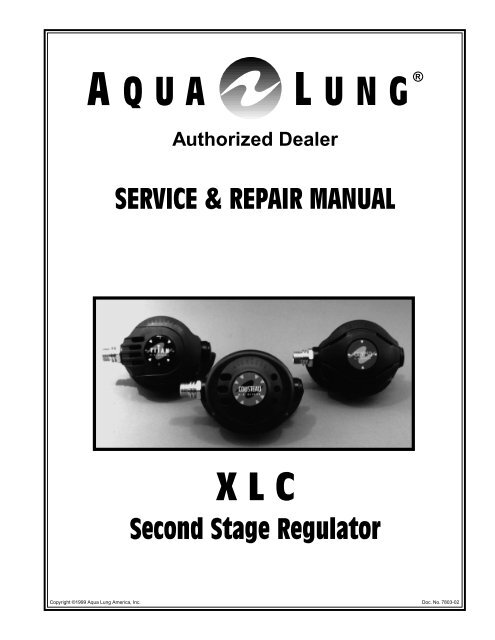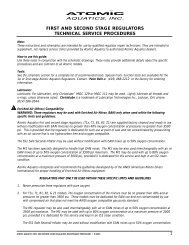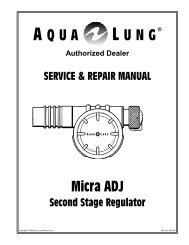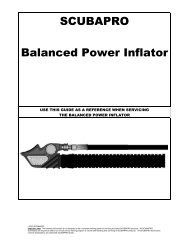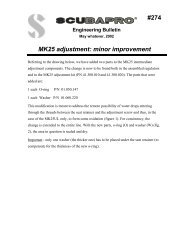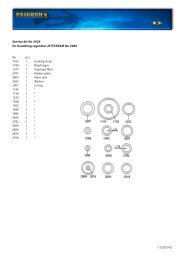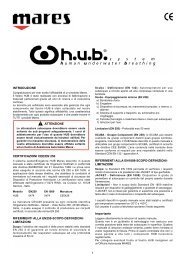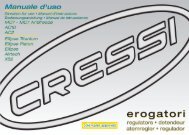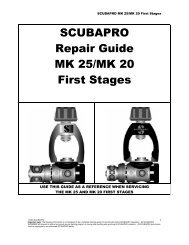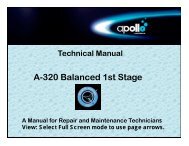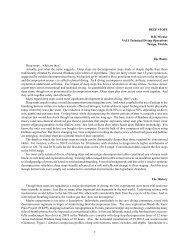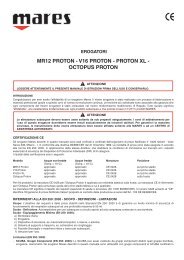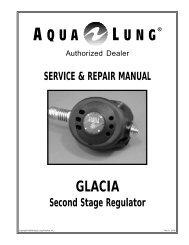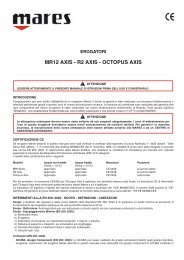XLC 2nd Stage Service Manual.pdf - Aberdeen Watersports
XLC 2nd Stage Service Manual.pdf - Aberdeen Watersports
XLC 2nd Stage Service Manual.pdf - Aberdeen Watersports
You also want an ePaper? Increase the reach of your titles
YUMPU automatically turns print PDFs into web optimized ePapers that Google loves.
®Authorized DealerSERVICE & REPAIR MANUALX L CSecond <strong>Stage</strong> RegulatorCopyright ©1999 Aqua Lung America, Inc. Doc. No. 7803-02
Table of ContentsIntroduction .................................................................................................... 3Warnings, Cautions, & Notes ........................................................................................... 3Scheduled <strong>Service</strong> ........................................................................................................... 3General Guidelines ........................................................................................................... 3Initial Inspection Procedure .......................................................................... 4External Inspection ........................................................................................................... 4Pressure Test .................................................................................................................... 4Disassembly Procedures............................................................................... 5Reassembly Procedures................................................................................ 8Adjustment Procedures ............................................................................... 11Final Assembly & Testing ............................................................................ 12Second stage Air Flow Test ............................................................................................ 13Second stage Opening Effort Test .................................................................................. 13Second <strong>Stage</strong> Purge Flow Test ...................................................................................... 13External Leak Test .......................................................................................................... 14Subjective Breathing Test ............................................................................................... 14Table 1 – Troubleshooting Guide ................................................................ 15Table 2 – Recommended Tool List .............................................................. 16Table 3 – Standard Parts Replacement Schedule ..................................... 16Table 4 – Torque Specifications .................................................................. 17Table 5 – Test Bench Specifications ........................................................... 17Procedure A – Cleaning & Lubrication....................................................... 18Table A – Recommended Lubricants & Cleaners...................................... 19Schematic Drawing ...................................................................................... 20
Doc. #7803-02<strong>Service</strong> & Repair <strong>Manual</strong> - <strong>XLC</strong> Second <strong>Stage</strong> RegulatorIntroductionThis manual provides factory prescribed proceduresfor the service and repair of the <strong>XLC</strong> secondstage regulator. It is not intended to be used as aninstructional manual for untrained personnel. Theprocedures outlined within this manual are to beperformed only by personnel who have receivedfactory authorized training through a factory sponsoredAqua Lung <strong>Service</strong> & Repair Seminar.If you do not completely understand all of theprocedures outlined in this manual, contact AquaLung to speak directly with a Technical Advisorbefore proceeding any further.Warnings, Cautions, & NotesPay special attention to information provided inwarnings, cautions, and notes that are accompaniedby one of these symbols:A WARNING indicates a procedure or situationthat may result in serious injury or death ifinstructions are not followed correctly.A CAUTION indicates any situation or techniquethat will result in potential damage to theproduct, or render the product unsafe if instructionsare not followed correctly.A NOTE is used to emphasize importantpoints, tips, and reminders.Scheduled <strong>Service</strong>Regulators should be given the same care andmaintenance as life support equipment. It is thereforeimportant to perform scheduled overhaul servicefor the <strong>XLC</strong>, complete with first stage, according tothe procedures outlined in this manual; at least oncea year with normal or infrequent use.NOTE: A unit that receives heavy or frequentuse, such as in rental, instruction, or commercialapplications, should be serviced at leasttwice each year - or more often - depending onthe conditions of use and the manner in whichit is maintained. (Refer to the care and maintenanceprocedures outlined in the RegulatorOwner’s <strong>Manual</strong>.)General Guidelines1. In order to correctly perform the proceduresoutlined in this manual, it is important to followeach step exactly in the order given. Read overthe entire manual to become familiar with allprocedures before attempting to disassemble orservice the <strong>XLC</strong> second stage, and to learnwhich specialty tools and replacement parts willbe required. Keep the manual open beside youfor reference while performing each procedure.Do not rely on memory.2. All service and repair should be carried out in awork area specifically set up and equipped forthe task. Adequate lighting, cleanliness, andeasy access to all required tools are essential formaintaining a professional repair facility.3. Before beginning any disassembly, it is importantto first perform the Initial Inspection procedure,and refer to Table 1 - Troubleshooting todetermine the possible cause of any symptomswhich may be present.4. As each individual regulator is disassembled,reusable components should be segregated toprevent them from mixing with non-reusableparts or parts from other regulators. Delicateparts, and those which contain critical sealingsurfaces, must be protected and isolated fromother parts to prevent damage during the cleaningprocedure.5. Use only genuine Aqua Lung parts purchaseddirectly from Aqua Lung when servicing anyAqua Lung product. Substitution with anothermanufacturer’s parts constitutes an after-marketmodification of the product, and renders theoriginal warranty null and void.6. Do not attempt to reuse mandatory replacementparts under any circumstances, regardless of theamount of use the product has received since itwas manufactured or last serviced.7. When reassembling, it is important to followevery torque specification prescribed in thismanual, using a calibrated torque wrench. Mostparts are made of either marine brass or plastic,and can be permanently damaged by unduestress caused by overtightening.
4 <strong>XLC</strong> Second <strong>Stage</strong> <strong>Service</strong> & Repair <strong>Manual</strong>Initial Inspection ProcedureEXTERNAL INSPECTION1. Visually inspect the sintered filter to check for any signs thatcontaminants may have entered the system, such as moisture,rust, aluminum oxide, or charcoal.NOTE: A green discoloration positively indicates that moisturehas entered the regulator, and internal corrosion istherefore likely to be found in the first stage. A white or rustcolored residue usually indicates that the regulator has beenused with a corroded aluminum or steel cylinder. Advise thecustomer of the proper methods for maintaining the regulator,and the possible need to obtain service for their cylinder.2. Slide back the hose protector(s) to inspect the condition of theLP hose at its fittings and along its length. Check closely forany signs of blistering or abrasion, or corrosion of the fittings.3. Inspect the condition of the mouthpiece to check for torn bitetabs, holes, or deterioration.Pressure Test1. Prior to performing any disassembly, ensure that the secondstage is connected to a first stage with a stable intermediatepressure of 135-140 psi, with no open ports or hoses.2. Listen closely to check for any signs of leakage from thesecond stage. If necessary, immerse the second stage in waterto locate the source of any leakage found and refer to Table 1 -Troubleshooting to determine its possible cause.CAUTION: If the second stage freeflows uncontrollably,immediately shut the cylinder valve and proceed directly tothe Disassembly Procedure. Do not attempt to furtherinspect the regulator while pressurized.3. Depress the purge button to determine whether sufficientairflow is provided to clear the second stage of water. Immediatelyafter releasing the purge button, listen closely to ensurethat no air continues to flow from the second stage.4. Turn the cylinder valve shut and depress the second stagepurge button to depressurize the regulator before proceedingto the following Disassembly Procedure.© 1999 Aqua Lung America, Inc.
<strong>XLC</strong> Second <strong>Stage</strong> <strong>Service</strong> & Repair <strong>Manual</strong> 5Disassembly ProceduresNOTE: Before performing any disassembly, refer to Table 4,which references all mandatory replacement parts. Theseparts must be replaced with new, and must not be reusedunder any circumstances - regardless of the age of theregulator or how much use it has received since it was lastserviced.Fig. 1 – Removing Purge CoverFig. 2 – Removal of End PlugCAUTION: To prevent damage to critical sealing surfaces,use only a plastic or brass O-ring removal tool (P/N 9440-22)when removing O-rings. Once an O-ring sealing surface hasbeen damaged, the part must be replaced with new in orderto prevent the possibility of leakage. DO NOT use a dentalpick, or any other type of steel instrument.1. While holding the inlet fitting(20) of the second stage securewith a 19mm open end wrench, apply 17mm (n") open-endwrench to the female fitting of the LP hose(16). Turn thefitting counter-clockwise to loosen and remove the hose fromthe second stage. Remove the O-rings(17&18) from the hoseand discard. Set the hose aside.2. Carefully snip the plastic mouthpiece clamp(26) and removethe mouthpiece(25) from the box bottom(22). Inspect themouthpiece to ensure it is free of any tears or cuts that maycause leakage of water into the second stage or other discomfort.Discard the mouthpiece or set it aside to be reused,depending on its condition.3. While holding the second stage secure, firmly grasp the collarof the front cover(3) which is seated over the sealed adjustmentport of the box bottom, opposite of the inlet side. Stretchthe collar over the adjustment port, and lift the front cover offthe box bottom until the opposite collar can be removed fromthe inlet fitting (see Fig. 1).4. If it is necessary, press out the stem of the purge button(2)from inside the front cover. Closely examine the front cover tocheck for any tears, distortion, deterioration, or other signs ofdamage. Replace it if found, or set it aside if it is in reusablecondition.5. Lift out the sealing ring(4) and diaphragm(5) from the boxbottom, and closely inspect the diaphragm to ensure that it isperfectly round and free of any tears, deterioration, or otherdamage. If deterioration or damage is found, discard thediaphragm and do not attempt to reuse.6. While squeezing the flanges of the end plug(28) together, pressthe end plug out so that it exits the box bottom (see Fig. 2).Remove and discard the O-ring(29), and closely examine theO-ring sealing surface of the end plug to check for any nicks orscratches. Discard if found, or set it aside if it is in reusablecondition.© 1999 Aqua Lung America, Inc.
6 <strong>XLC</strong> Second <strong>Stage</strong> <strong>Service</strong> & Repair <strong>Manual</strong>7. While holding the second stage secure with one hand, apply a19mm open end wrench to the inlet fitting. Hold the lever(9)partially depressed, and turn the inlet fitting counter-clockwiseto loosen and remove from the valve insert(11). Remove anddiscard the O-ring(21).8. Apply a medium blade screwdriver to the slotted head of thecrown(19) inside the inlet fitting, and hold the inlet fittingsecure while turning the crown counter-clockwise to disengagethe threads.9. When the crown has been unthreaded from the inlet fitting,carefully insert the pin of the extraction tool (P/N 1094-36)into the opposite end of the inlet fitting and through the centerof the crown. Gently press the crown out onto a paddedsurface (see Fig. 3). Remove and discard the O-ring(18).10. Closely examine the crown with the use of magnifier, checkingfor any scoring, nicks, or other damage to the polishedsealing surface. If damage is found, discard the crown, and donot attempt to reuse. If it is in reusable condition, set it asideon a soft surface to prevent damage to the sealing edge.11. Press the valve insert(11) with lever assembly into the boxbottom by inserting a finger through the inlet opening. Gentlylift the assembly out of the box bottom, being careful to avoidpulling or tugging on the lever(9).12. Stand the valve assembly vertical on the head of the poppet,with the lever facing up, and depress the valve insert to exposethe locknut(7). While holding the valve insert fully depressed,apply a 4" nut driver to turn the locknut counter-clockwiseuntil it has disengaged from the threads of the poppet (see Fig.4). Remove the locknut, washer(8), and lever(9), and slowlyrelax the valve insert to lift it off the poppet(13) andspring(12). Discard the locknut, and do not attempt to reuse.12a. Closely inspect the shape and condition of the lever to ensureit is not bent, corroded, or otherwise damaged. If any signs ofdamage or corrosion are found, discard the lever and do notreuse.12b. Closely examine the poppet spring with a magnifier to ensureit is not damaged (bent) or corroded. If any signs of damageor corrosion are found, discard the spring and do not reuse.13. Using a plastic or brass O-ring tool, lightly stick the center ofthe LP seat(14) inside the head of the poppet and lift the seatout, being very careful to avoid damaging the poppet. Set theseat aside to be used as an aid during reassembly, and inspectthe head of the poppet to check for any nicks, scratches, orother signs of damage. The through-hole beneath the LP seatcavity should be clear and free of any obstructions. If anysigns of damage are found, discard the poppet and do notattempt to reuse.Fig. 3 – Crown RemovalFig. 4 – Disassembly of Valve© 1999 Aqua Lung America, Inc.
<strong>XLC</strong> Second <strong>Stage</strong> <strong>Service</strong> & Repair <strong>Manual</strong> 7NOTE: The used LP seat is an essential aid to the reassemblyprocedure for the valve insert. Do not discard the seatuntil the reassembly and final adjustment procedures haveboth been performed, and the regulator is functioning satisfactorily.14. Closely examine the top of the valve insert to identify whetherthe poppet bearing is round in the center (see Fig. 5a), or if it issquare (see Fig. 5b). If it is round, which identifies it as aRevision A part, it must be pressed out from inside the valveinsert, using the handle of the extraction tool. If the poppetbearing is square, which identifies it as Revision B, it must bepressed into the valve insert by applying the handle of theextraction tool directly over it. Discard the poppet bearing anddo not reuse, regardless of which revision it belongs to.Fig. 5 – Poppet Bearing IdentificationFig. 6 – V.A.S. Circlip RemovalCAUTION: If the poppet bearing is identified as a Revision Apart, it is important to replace both the valve insert andpoppet bearing with newer Revision B parts. Do not attemptto reuse a Revision A valve insert.15. Place the box bottom on a flat, padded surface, so that theoutlet boss and exhaust tee face up. While holding the boxbottom secure, place the tines of the Circlip/ Retaining RingTool (P/N 1078-46) squarely against the ends of the circlip(6)(see Fig. 6). Gently press the circlip straight off the vaneadjustment switch(24), and set it aside.16. Pull the vane adjustment switch straight up and out of theoutlet boss of the box bottom. Remove and discard the O-ring(23), and set the switch aside.17. While holding the box bottom secure, remove the exhausttee(30) by firmly pulling one side off and then the other.CAUTION: Do not use a tool to remove the exhaust tee.Doing so may cause serious damage to the seating flange,requiring replacement of the box bottom.18. Remove the exhaust valve diaphragm(27) from the box bottomand discard.This concludes the disassembly of the <strong>XLC</strong> secondstage. Refer directly to Procedure A and Table A, titledCleaning & Lubrication, before proceeding to the ReassemblyProcedures.© 1999 Aqua Lung America, Inc.
8 <strong>XLC</strong> Second <strong>Stage</strong> <strong>Service</strong> & Repair <strong>Manual</strong>Reassembly ProceduresNOTE: Before performing any reassembly, it is important toinspect all parts, both new and those that are being reused,to ensure that every part and component is perfectly cleanand free of any dust, corrosion, or blemishes. Check all O-rings to ensure they are clean and supple before dressingwith either Christo-Lube ® or Dow 111 silicone grease.WARNING: Use only genuine Aqua Lung parts, subassemblies,and components whenever assembling any Aqua Lungproduct. DO NOT attempt to substitute an Aqua Lung partwith another manufacturer’s, regardless of any similarity inshape, size, or appearance. Doing so may render the productunsafe, and could result in serious injury or death.1. Install the O-ring(23) onto the vane adjustment switch(24).2. Mate the stem of the vane switch into its respective hole in thebox bottom(22), above the outlet boss, and align the matingpin above the positioning guide (see Fig. 7). When the switchis correctly aligned, press it down and into place so that it isproperly seated inside the box bottom.3. Press the circlip(6) into the recessed ledge in the forks of theCirclip/ Retaining Ring Tool (P/N 1078-46), with its flat sidefacing down and the open end facing out of the tool (see Fig.8). The spring tension of the tool will hold the circlip in placewhile it is being positioned inside the box bottom.4. While holding the vane switch in place, set the box bottom ona flat surface with the open side facing down and the switch at12 O’clock. Guide the tool holding the circlip into the outletboss, with the top surface of the tool held flush against theceiling, directly behind the vane. Press the circlip evenly ontothe groove of the vane stem until it snaps audibly into place(see Fig. 9). Remove the tool and examine closely to ensurethe circlip is seated completely inside the groove. Removeand reinstall the circlip if necessary.CAUTION: It is important to ensure that the vane adjustmentswitch, O-ring, and circlip are correctly installed inorder to maintain the watertight integrity of the box bottomassembly. Improper installation may result in flooding of thesecond stage.5. Install the exhaust valve diaphragm(27) into the box bottomby gently pulling the stem through the hole in the center of thesupport spokes, until the barb has passed through and issecurely seated inside the box bottom. Carefully snip off theexcess material of the stem with a small pair of scissors.6. Install the exhaust tee(30) onto the box bottom by fitting itover one upper corner of the seating flange and then stretchingit over the other. Firmly press the lower portion of the teeonto the flange until it is completely seated.Fig. 7 – V.A.S. AlignmentFlat side faces downFig. 8 – Loading Circlip ToolFig. 9 – V.A.S. Circlip Installation© 1999 Aqua Lung America, Inc.
<strong>XLC</strong> Second <strong>Stage</strong> <strong>Service</strong> & Repair <strong>Manual</strong> 9Fig. 10 – Crown InstallationFig. 11 – Poppet Bearing InstallationCAUTION: Do not use a tool to install the exhaust tee.Doing so may cause serious damage to the seating flange,requiring replacement of the box bottom.7. Install the O-ring(18) onto the crown(19), and carefully insertthe threaded end of the crown into the hose connection end ofthe inlet fitting(20). Gently press it in further with the bluntend of the extraction tool (P/N 1094-36) until it stops (see Fig.10).8. Apply a medium blade screwdriver to the slotted head of theadjustable crown, and turn the crown clockwise to engage thethreads. Continue turning the crown clockwise to the fullextent of its thread engagement, and stop turning when resistanceis felt. Then turn the crown out counter-clockwiseexactly 22 turns counterclockwise to arrive at its correctpreliminary setting.9. Stand the inlet fitting vertical on a flat surface with the sealingedge of the crown facing up inside. Install the O-ring(21) intothe groove at the base of the threads, just above the hex feature.10. Lay the previously used LP seat inside the inlet fitting, overthe sealing edge of the crown.NOTE: It is essential to use a spare LP seat in order toprevent damage to the new seat while performing the followingsteps of the reassembly procedure.11. Place the poppet bearing(10) over the pin of the extraction toolwith the square feature facing up. Guide the pin of the toolinto the open end of the valve insert(11) and out through thesquare hole in its center. While sighting through the top of thevalve insert, rotate the tool as needed to align the squarefeature of the poppet bearing with the square hole, and pressthe tool upward to seat the bearing securely in place (see Fig.11). When finished, check to ensure that the top of the poppetbearing is flush with the top of the valve insert.12. Press the new LP seat(14) into the cavity in the head of thepoppet(13), with the smooth side facing out.13. Stand the poppet on its head inside the top of the inlet fitting,and place the spring(12) over the poppet shaft.14. Hold the inlet fitting secure, and mate the valve insert withpoppet bearing down over the poppet shaft. Press the valveinsert downward to compress the spring while turning itclockwise to engage the threads of the inlet fitting, and thencontinue turning it slowly until the threaded portion of thepoppet shaft stands outside the poppet bearing.© 1999 Aqua Lung America, Inc.
10 <strong>XLC</strong> Second <strong>Stage</strong> <strong>Service</strong> & Repair <strong>Manual</strong>CAUTION: If resistance is felt, immediately stop and unscrewthe valve insert from the inlet fitting to check thealignment of the poppet shaft and poppet bearing. Excessiveforce and misalignment will otherwise result in damageto the poppet bearing, requiring its replacement.15. While the inlet fitting and valve insert are laying horizontal,rotate both parts until the outlet ports of the valve insert facetowards 6 O’clock. Lay the arms of the lever(9) inside thegroove of the valve insert, straddling the poppet shaft, so thatthe curved portion of the lever faces towards 12 O'clock.16. Place the washer(8) over the poppet shaft, followed by thelocknut(7), with the flat side facing down. Being careful toavoid disturbing the lever, turn the locknut clockwise by handto engage the threads of the poppet, and then apply a 4" nutdriver to turn it further, until 1-2 threads of the poppet shaftare visible above the top of the locknut (see Fig. 12).17. Hold the valve insert and lever stationary and upright with onehand, and slowly unscrew the inlet fitting counter-clockwise toloosen and remove from beneath it, while watching to ensurethat the lever rises slightly as the poppet shaft retracts into thevalve insert. Remove and discard the previously used LP seatfrom the inlet fitting.18. Lay the valve insert and lever assembly inside the box bottom,facing to the left above the exhaust tee for right hand configuration,or to the right for left hand configuration. With thelever facing up and the indexed feature of the valve insertfacing down, mate the valve insert into the desired inlet port ofthe box bottom until it is seated flush against the side (see Fig.13).CAUTION: Do not attempt to change the configuration ofthe regulator from right hand to left hand, or vice versa,without first replacing the valve insert with the correct part.(Refer to the schematic and parts list shown on page 18.)Failure to install the valve insert in its correct configurationwill result in the misdirection of airflow and may degrade theregulator's performance.19. While holding the valve insert securely seated inside the boxbottom and the lever depressed, mate the shorter threaded endof the inlet fitting through the inlet port on the opposite side.Turn the inlet fitting clockwise by hand until finger snug, andthen apply a torque wrench with a 19mm crow foot to tightenit to a torque measurement of 50 (±5) inch-pounds.20. Install the mouthpiece(25) onto the box bottom, and lightlyfasten a clamp(26) onto the groove of the mouthpiece. Turnthe clamp so that the locking tab is facing toward the inlet sideof the box bottom, and pull the clamp sufficiently snug. Snipthe extra length with a small pair of scissors or wire cutters.1-2 threadsFig. 12 – Locknut Preliminary SettingFig. 13 – Correct Alignment ofValve Insert with Box Bottom (Right Hand)© 1999 Aqua Lung America, Inc.
<strong>XLC</strong> Second <strong>Stage</strong> <strong>Service</strong> & Repair <strong>Manual</strong> 11Adjustment ProceduresCAUTION: Prior to adjusting and testing the <strong>XLC</strong> secondstage regulator, the accompanying first stage must be correctlyserviced, adjusted to a stable intermediate pressure of135-140 psi, and fully tested. Refer to the appropriate firststage service manual before attempting to perform theadjustment and testing of the Impulse second stage.1. Thread the male fitting of the IP hose into the low pressureport of the first stage, and apply a torque wrench with 17mm(n") crow-foot to tighten to 40 inch-pounds (±2).2. Connect an intermediate pressure test gauge (P/N 1116-10) tothe first stage via a separate low pressure hose.3. Attach the female fitting of the second stage low pressure hoseto the In-Line Adjustment Tool (P/N 1001-95) by mating theswivel nut onto the male threaded end of the tool. Turn theswivel nut clockwise until finger snug.4. Pull back the knob of the tool to retract the adjusting stem,and mate the female threaded end of the tool onto the secondstageinlet fitting. While holding the tool secure, turn thesecond stage clockwise until lightly snug (see Fig. 14).5. Set the vane adjustment switch to the “MIN” position, andconnect the first stage to a filtered air source of 3,000 psi.Fig. 14 – Inline Adjustment Tool ConnectionNOTE: The preferred air source for final tuning and testing isa flow bench with accurately calibrated gauges. If a flowbench is not available, a scuba cylinder may be used, followingthe subjective breathing test provided on page 12.7. Slowly open the valve of the air supply to pressurize theregulator. Press the knob of the inline adjustment tool inward,and gently turn the knob until it can be felt that the adjustmentstem has mated into the slotted head of the crown. Continueto hold the knob inward, in order to prevent it from beingpressed outward by the internal air pressure.a. If airflow cannot be heard, slowly turn the crown outcounter-clockwise only until a very slight leak is present.b. When a slight leak has been established, slowly turn thecrown clockwise in very small increments of adjustmentwhile lightly depressing the lever to cycle the regulator.Pause to listen after each adjustment to determine whetherthe airflow has stopped. It is important to adjust only untilthe airflow has stopped.c. When the airflow is stopped and no leakage can be heardafter cycling the regulator, proceed to adjust the crownfurther clockwise 45 degrees for a primary second stage,or 180 degrees for an octopus. Then, release the knob ofthe inline adjustment tool to ensure that it no longer makescontact with the orifice.© 1999 Aqua Lung America, Inc.
12 <strong>XLC</strong> Second <strong>Stage</strong> <strong>Service</strong> & Repair <strong>Manual</strong>CAUTION: Over-adjustment of the orifice crown will causeexcessive spring load in the second stage valve, and mayseverely degrade the performance of the regulator.8. Apply a hand driver with 4" tapered hex to the locknut,through the open port of the box bottom. Turn the locknutclockwise in very small increments of adjustment, only untilthe lever stands at its maximum height; even with the rim ofthe box bottom (see Fig. 15).9. Lightly depress the lever several times to cycle the regulatorand listen closely to check for the return of any leakage, whichmay indicate that the locknut has been over-adjusted. Ifleakage is detected, it is important to return the crown andlocknut to their original preliminary settings, and then repeatsteps 7-8 before proceeding any further.CAUTION: Over-adjustment of the locknut will retract thepoppet from the crown, resulting in leakage past the LP seat.Do not attempt to correct this condition by only readjustingthe crown further in clockwise. Doing so may dangerouslyincrease the opening effort and inhalation resistance of theregulator due to excessive spring load in the second stagevalve.10. When the crown and locknut are properly set with no leaksand the lever is standing at its correct height, turn the valve ofthe air source completely shut, and purge the second stage todepressurize the system. Disconnect the in-line adjustmenttool from the second stage and the LP hose.Final Assembly & Testing1. Install the purge button(2) with decal(1) into the purgecover(3), if it was previously removed, with the logo facingright side up and horizontally straight. Insert the femalefitting of the LP hose through the retaining collar on the leftside of the purge cover for right-handed configuration, orthrough the right side for left-handed (see Fig. 16). For eitherconfiguration, check to ensure that the purge cover will beproperly oriented with the logo facing right side up when it isfitted over the second stage. Slide the purge cover up the hoseso that it doesn’t interfere with the next step.2. Connect the female fitting of the LP hose to the second stageinlet and tighten by hand until finger snug. Apply a torquewrench with n” crow-foot to tighten the IP hose fitting to atorque measurement of 40 inch-lbs (±3).3. Install the O-ring(29) onto the end plug(28), and insert the endplug into the box bottom so that it locks securely in place.4. Fit the sealing ring(4) inside the top of the diaphragm(5), andinstall these together into the box bottom. Check to ensurethat the diaphragm is seated flush on all sides.Fig. 15 – Lever Height Preliminary SettingFig. 16 – Purge Cover Installation© 1999 Aqua Lung America, Inc.
<strong>XLC</strong> Second <strong>Stage</strong> <strong>Service</strong> & Repair <strong>Manual</strong> 135. Slide the purge cover down the hose, and fit the retainingcollar over the inlet port of the box bottom. Next, fit the purgecover over the top of the box bottom and stretch the otherretaining collar over the sealed adjustment port. Check toensure that the purge cover is seated securely on all sides.NOTE: Before performing the following procedure, refer toTable 5, titled Test Bench Specifications - <strong>XLC</strong> <strong>2nd</strong> <strong>Stage</strong>.NOTE: If an accurately calibrated airflow test bench is notavailable, proceed to the Subjective Tuning Proceduresprovided on the following page.Second stage Air Flow Test1. Connect the first stage regulator to a calibrated test bench andpressurize the system to 3000 (±100) psi.2. Place the second stage mouthpiece over the mouthpieceadapter. Slowly turn the flowmeter control knob until the flowreaches a minimum of 15 SCFM (425 liters per minute). Thereading on the Magnahelic gauge (inhalation / exhalationeffort gauge) should indicate no more than +6.O” H 2 O. If thereading exceeds +6.0" H 2 O, refer to refer to Table 1 - Troubleshootingfor corrective guidelines and specific procedures.Second stage Opening Effort Test1. Turn the flowmeter control knob shut, and then slowly reopenwhile watching both the Magnahelic gauge and the intermediatepressure gauge.2. When the intermediate pressure gauge begins to drop belowthe intermediate pressure “lockup,” the Magnahelic gaugeshould indicate an opening effort of +.8" to +1.4" of H 2 O(primary) or +1.2" to +1.8" (octopus). If the opening effort isnot within this range, refer to Table 1 - Troubleshooting.Second <strong>Stage</strong> Purge Flow Test1. Turn off the flowmeter control knob. Next, while the secondstage is still mounted on the mouthpiece adapter, watch theflowmeter gauge and depress the purge button until the secondstage valve is completely open. The flowmeter gauge mustindicate a minimum of +5.0 SCFM (142 Liters per minute.).If the purge flow is less than +5.0 SCFM, refer to Table 1 -Troubleshooting.2. When purge flow is correct, remove the second-stage from themouthpiece adapter on the flow test bench. Shut the valve ofthe test bench, and purge the second stage to depressurize thesystem. Remove the regulator.© 1999 Aqua Lung America, Inc.
14 <strong>XLC</strong> Second <strong>Stage</strong> <strong>Service</strong> & Repair <strong>Manual</strong>External Leak Test1. After disconnecting the regulator from the flow bench, connectit to a scuba cylinder filled to approximately 3,000 psi.Open the cylinder valve to repressurize the regulator, andsubmerge the entire system in a test tank of clean water.2. Observe any bubbles arising from the submerged regulatorover a one minute period. The recommended time is necessarydue to slower bubble formation that occurs in smallerleaks. Bubbles indicate a leak, which requires that the systemmust be disassembled at the source to check sealing surfaces,assembly sequence and component positioning in order tocorrect the problem(s).NOTE: Extremely small leaks may be better detected byapplying a soap solution or Snoop to the leak area.Bubble streams will indicate the source of the leak. Beforedisassembling to correct any leaks, rinse the entire regulatorthoroughly with fresh water and blow out all residual moisturewith filtered, low-pressure (50 psi) air. Disassemble andremedy the problem, referring to Table 1 - Troubleshooting.Subjective Breathing Test1. Depress the purge cover fully to ensure that an adequatevolume of air needed to clear the second stage flows throughthe mouthpiece. Then, inhale slowly but deeply from themouthpiece. A properly serviced and adjusted regulatorshould deliver air upon deep inhalation without excessiveinhalation effort, freeflow, or “fluttering” of the second-stagediaphragm. When exhaling, there should be no fluttering orsticking of the exhalation valve. If any of these problemsoccur, refer to Table 1 - Troubleshooting.This concludes annual service procedures for the <strong>XLC</strong>Second <strong>Stage</strong> Regulator.© 1999 Aqua Lung America, Inc.
<strong>XLC</strong> Second <strong>Stage</strong> <strong>Service</strong> & Repair <strong>Manual</strong> 15Table 1Troubleshooting Guide – <strong>XLC</strong> Second <strong>Stage</strong>SYMPTOM POSSIBLE CAUSE TREATMENTLeakage or freeflow from 1. High first-stage intermediate pressure. 1. Refer to first-stage Troubleshootsecondstage (should be 135-140 psi) ing Guide.2. LP seat(14) damaged or worn. 2. Replace LP seat.3. Crown(19) and/or locknut(7) adjusted 3. Reset crown and locknut toincorrectly, lever set too high.preliminary settings, and repeatAdjustment Procedures.4. Crown(19) sealing surface damaged. 4. Replace crown.5. Poppet spring(12) damaged. 5. Replace poppet spring.Low purge or excessive work 1. Low intermediate pressure. 1. Refer to first-stage Troubleshootofbreathing (full cylinder) (should be 135-140 psi) ing Guide.2. Crown(19) and/or locknut(7) adjusted 2. Reset crown and locknut toincorrectly, lever set too low.preliminary settings, and repeatAdjustment Procedures.3. Intermediate pressure hose(16) 3. Clean or replace hose.clogged or obstructed.External air leakage 1. Intermediate pressure hose loose. 1. Tighten to 40 inch-lbs at female(Immersion Test)second-stage fitting.2. Crown O-ring(18) damaged. 2. Disassemble and replace O-ring.3. Box bottom(22) damaged. 3. Disassemble and replace boxbottom.Water entering second-stage 1. Hole in mouthpiece(25). 1. Replace mouthpiece.2. Demand diaphragm(5) damaged. 2. Replace demand diaphragm.3. Exhaust diaphragm(27) damaged. 3. Replace exhaust diaphragm(s).4. Vane Adjustment Switch O-ring(23) 4. Disassemble and replace O-ring.dirty, damaged, or worn.5. Diaphragm improperly seated 5. Remove front cover(3) and propbetweenbox bottom(22) anderly reassemble sealing ring withsealing ring(4).diaphragm . (Check for distortion.)6. Box bottom damaged. 6. Disassemble and replace box(Check exhaust valve sealing surface.) bottom.7. Valve insert O-ring(21) damaged. 7. Disassemble and replace O-ring.8. End plug O-ring(29) worn or damaged. 8. Disassemble and replace O-ring.CAUTION: Recommended treatments which require disassembly of the regulatormust be performed during a complete overhaul, according to the prescribed proceduresfor scheduled, annual service. Do not attempt to perform partial service.NOTE: This is a partial list of possible problems and recommended treatments. Formore information, refer to the second-stage troubleshooting guide, or contact theRepair Department for assistance with problems not described here.© 1999 Aqua Lung America, Inc.
16 <strong>XLC</strong> Second <strong>Stage</strong> <strong>Service</strong> & Repair <strong>Manual</strong>Table 2Recommended Tool ListPART NO. DESCRIPTION APPLICATION1116-10 I.P. test gauge Intermediate pressure testingN/A 0-120 inch-lbs torque wrench Inlet & hose fittings installation9440-22 O-ring tools O-ring removal & installationN/A Magnifier w/ illumination Sealing surface inspectionN/A Ultrasonic cleaner Brass & stainless steel parts cleaningN/A Medium blade screwdriver Crown removal/ installationN/A 19mm wrench & crow foot Hex nut removal/ installationN/A 17mm (n") wrench & crow foot IP hose fittingN/A 4" nut driver Valve disassembly/ assembly/ adjustment1078-46 Circlip & Retaining Ring Tool C-clip & retaining ring removal/ installation1094-36 Seat extraction/installation tool Crown removal & installation1001-95 In-line adjustment tool Final adjustment & tuningTable 3Standard Parts Replacement SchedulePART NUMBER DESCRIPTION KEY NUMBER QTY1025-10 Locknut 7 11041-34 Poppet Bearing 10 11067-38 LP Seat 14 19570-25 O-ring (Cousteau Only) 15 18200-11 O-ring (Titan, Calypso, Octopus) 15 18200-10 O-ring 17, 18, 23 38200-15 O-ring 21 & 29 21049-13 Clamp 26 11078-22 Exhaust Diaphragm 27 1© 1999 Aqua Lung America, Inc.
<strong>XLC</strong> Second <strong>Stage</strong> <strong>Service</strong> & Repair <strong>Manual</strong> 17Table 4Torque SpecificationsPART NUMBER DESCRIPTION / KEY NUMBER TORQUE1005-35, -36, or -37 LP Hose Female Fitting / 16 40 (±3) inch-lbs1041-06 Inlet Fitting/ 20 50 (±5) inch-lbsTable 5Test Bench SpecificationsTEST CONDITION ACCEPTABLE RANGELeak test Inlet 2,500-3,000 (±100) psi NoneIntermediate pressure Inlet 2,500-3,000 (±100) psi 135-140 psiIntermediate pressure creep Inlet 2,500-3,000 (±100) psi5 psi max between 5 to 15 secondsafter cycling regulator (purge)Opening effort Inlet 2,500-3,000 (±100) psi, +.8 to +1.4 inch H 20 (primary)intermediate pressure 135-140 psi +.8 to +1.8 inch H 20 (octopus)Flow effort Intermediate pressure 135-140 psi +6 inches H 20 (maximum)at 15 SCFMPurge flow Intermediate pressure 135-140 psi 5.0 SCFM flow rate (minimum)© 1999 Aqua Lung America, Inc.
18 <strong>XLC</strong> Second <strong>Stage</strong> <strong>Service</strong> & Repair <strong>Manual</strong>Procedure ACleaning & Lubrication(All Aqua Lung Regulators)1. Acid Bath - Aqua Lung strongly recommends ChromeSafe regulator cleaner (P/N 0201-05) for cleaningall reusable brass and stainless steel parts. ChromeSafe is a specially formulated cleaner that doesnot harm rubber or Teflon parts, yet effectively removes silicone grease, corrosion, and grime from metalparts, leaving only a brilliant shine. For best results, soak parts in an ultrasonic cleaner for 5 to 15minutes, unless the chrome finish is chipped or flaking. Parts with damage to their chrome finish shouldbe cleaned separately outside the ultrasonic cleaner to avoid agitation. Be certain to isolate more delicateparts, such as orifice cones, to prevent damage to sealing surfaces.CAUTION: Harsh acids, such as muriatic acid, may cause damage to parts and must be strictlyavoided. White vinegar, although less effective, is one suitable substitute for ChromeSafe .CAUTION: Ultrasonic cleaning times in excess of 15 minutes may damage the chrome finish of certainparts. Be certain to use a timer, and do not leave parts unattended while cleaning.NOTE: Although ChromeSafe contains a degreasing agent, cleaning heavily greased parts inChromeSafe will shorten the effective life of the solution, and require it to be replaced on a morefrequent basis. Heavily greased parts may be degreased in a solution of warm water and mild dishdetergent prior to being placed in the acid bath.2. Fresh Water Rinse - If tap water is extremely “hard,” distilled water may be used to prevent any mineralresidue. Remove parts from the acid bath and place directly into this rinse. Agitate lightly, and allow tosoak for 5-10 minutes. Remove and blow dry with low pressure (25 psi) filtered air, and inspect closelyto ensure proper cleaning and like-new condition.ANODIZED ALUMINUM, PLASTIC & RUBBER PARTSAnodized aluminum parts and parts made of plastic or rubber, such as box bottoms, box tops, dust caps,etc., may be soaked and cleaned in a solution of warm water mixed with mild dish soap. Use only a softnylon toothbrush to scrub away any deposits. Thoroughly blow dry, using low pressure filtered air.HOSESIf buildup of corrosion is severe, it is permissible to soak only the hose fittings in ChromeSafe cleaneras needed, and not allow any solution to enter the hose. Rinse in fresh water and allow to dry with thecleaned ends hanging down. Blow filtered air through them prior to installing onto the regulator.LUBRICATION AND DRESSINGAll O-rings should be lubricated with either Christo-Lube ® (preferred for high pressure systems) or DowCorning ® 111 food grade silicone grease . Dress the O-rings with a very light film of grease, and removeany visible excess by running the O-ring between thumb and forefinger. Avoid applying excessiveamounts of silicone grease, as this will attract particulate matter that may cause damage to the O-ring.Hoses and other black rubber parts may be dressed and preserved using a clean cloth impregnated with apump silicone milk.CAUTION: Aerosol spray silicone must be strictly avoided. Do not attempt to use as a substitute forsilicone grease.CAUTION: Do not apply any form of silicone lubricant to silicone rubber parts, as this will cause themto deteriorate prematurely.© 1999 Aqua Lung America, Inc.
<strong>XLC</strong> Second <strong>Stage</strong> <strong>Service</strong> & Repair <strong>Manual</strong> 19Table ARecommended Lubricants & Cleaners(All Aqua Lung Regulators)LUBRICANT / CLEANER APPLICATION SOURCEChristo-Lube ® All O-rings seals; cylinder valve threads Lubrication Technologies(preferred for high pressure DIN systems) 310 Morton StreetJackson, OH 45640(614) 286-2644Dow Corning ® 111 All O-ring seals Dow Corning Corp.(pure silicone grease) P.O. Box 1767-TMidland, MI 48640800-248-2481CAUTION: Silicone rubber requires no lubrication or preservative treatment. DO NOTapply silicone grease or spray to silicone rubber parts. Doing so will cause a chemicalbreakdown and premature deterioration of the material.Silicone Pump General preservative/conditioner for McNett Corp.(non-aerosol silicone milk spray) hoses, instrument console boots, etc. P.O. Box 996Bellingham, WA 98227800-221-7325CAUTION: Aerosol spray silicone should be avoided because (1) common aerosolpropellants may attack plastic and rubber parts, and (2) because only a slight amountof silicone remains after the solvent evaporates, and provides no lasting benefit.Anti-Seize Lubricant #80208 M.A.S. cylinder adapter - female threads Permatex Industrial Corp.(food grade - U.S.D.A. approved Micra ADJ adjustment screw 705 N. Mountain Rd.for conformance to MIL-A-907-E) Newington, CT 06111(860) 520-5000ChromeSafe Degreaser and acid bath for reusable Aqua Lung P/N 0201-05(ultrasonic cleaning solution) stainless steel and brass parts. (1 quart)Oakite #31 Acid bath for reusable stainless Oakite Products, Inc.steel and brass parts.50 Valley RoadBerkeley Heights, NJ 07922White distilled vinegar Acid bath for reusable stainless "Household" grade(100 gr.) steel and brass parts.CAUTION: DO NOT use muriatic acid for the cleaning of any parts. Muriatic acid,even when strongly diluted, can harm chrome plating, and may leave a residue that isharmful to O-ring seals and other parts.Liquid dishwashing detergent Degreaser for brass and stainless steel parts, "Household" grade(diluted with warm water) general cleaning solution for plastic, rubber,and anodized aluminum parts.Snoop Leak testing Nupro Company400 E. 345th St.Willoughby, OH 44094440-951-7100© 1999 Aqua Lung America, Inc.
20 <strong>XLC</strong> Second <strong>Stage</strong> <strong>Service</strong> & Repair <strong>Manual</strong><strong>XLC</strong> Second <strong>Stage</strong>Key # Part # Description Key # Part # Description----- 1041-18 <strong>XLC</strong> Second <strong>Stage</strong>----- 9000-10 Overhaul Parts Kit1 ----- 1041-85 Decal, Titan----- 1041-84 Decal, Cousteau----- 1051-84 Decal, Calypso----- 1041-86 Decal, Octopus2 ----- 1041-07 Purge Button3a ---- 1041-03 Front Cover, Calypso3b ---- 1041-42 Front Cover, Titan3c ---- 1041-43 Front Cover, Cousteaun/s --- 1041-28 Front Cover, Octopus4 ----- 1041-09 Sealing Ring5 ----- 1041-23 Diaphragm6 ----- 8601-37 Circlip7 ----- 1025-10 Locknut8 ----- 1041-29 Washer9 ----- 1041-08 Lever10 ---- 1041-34 Poppet Bearing11 ---- 1041-32 Valve Insert (Right Hand)----- 1041-31 Valve Insert (Left Hand)12 ---- 1041-27 Spring13 ---- 1041-22 Poppet14 ---- 1067-38 LP Seat15 ---- 9570-25 O-ring, Cousteau----- 8200-11 O-ring, Titan, Calypso, Octopus16 ---- 1005-35 Hose, Cousteau----- 1005-36 Hose, Titan, Calypso----- 1005-37 Hose, Octopus, 39"17 ---- 8200-10 O-ring18 ---- 8200-10 O-ring19 ---- 1078-05 Crown20 ---- 1041-06 Inlet Fitting21 ---- 8200-15 O-ring22 ---- 1041-01 Box Bottom23 ---- 8200-10 O-ring24 ---- 1041-13 Vane Adjustment Switch25 ---- 1094-38 Mouthpiece, Comfo Bite ----- 1041-38 Mouthpiece, Octopus26 ---- 1049-13 Clamp27 ---- 1078-22 Exhaust Diaphragm28 ---- 1041-12 End Plug29 ---- 8200-15 O-ring30a --- 1041-02 Exhaust Tee30b --- 1041-24 Exhaust Tee, OctopusPart numbers in BOLD ITALICS indicate standard overhaulreplacement part.© 1999 Aqua Lung America, Inc.
<strong>XLC</strong> Second <strong>Stage</strong> <strong>Service</strong> & Repair <strong>Manual</strong> 21TECHNICIAN'S NOTES© 1999 Aqua Lung America, Inc.


